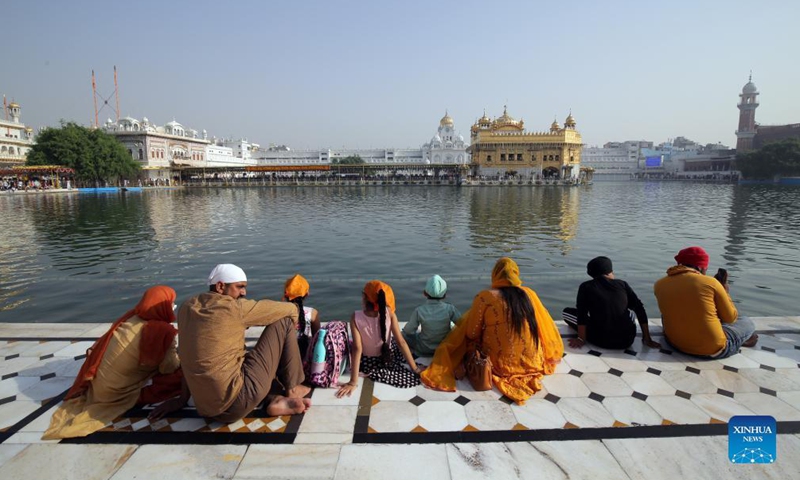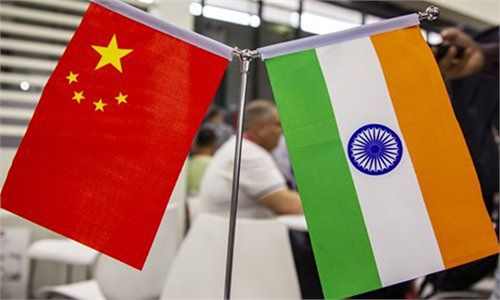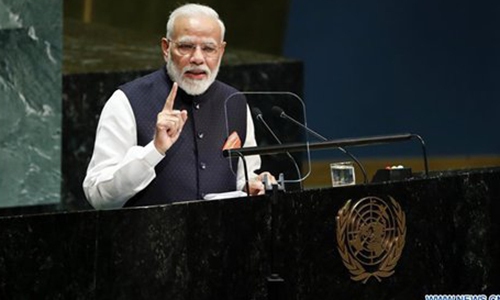
Devotees visit the Golden Temple, the holiest of Sikh shrines, on the occasion of the birth anniversary of the fourth Sikh Guru in Amritsar of India's northern state of Punjab, Oct. 22, 2021.Photo:Xinhua
India, the world's third-largest carbon emitter, has finally outlined its commitment on climate change, as Indian Prime Minister Narendra Modi pledged to reach net-zero carbon emissions by 2070 at the COP26 in Glasgow, the UK.
Although some Western media stressed that India's 2070 target may have disappointed some activists and experts in Glasgow - it is two decades behind US and EU's goal of hitting net zero by 2050 and 10 years behind China's 2060 carbon neutrality plan - some Chinese experts lauded India for its commitment, saying the country's goals are determined by national conditions. But India does face big challenges to fulfill its ambition.
"Net zero," or carbon neutrality, refers to the balance between the produced and erased greenhouse gas in the atmosphere by natural means or through technology. Although 2070 is two decades beyond what Western scientists say is needed to "avert a catastrophic climate impact," Modi stressed that India is home to 17 percent of the world's population but is only responsible for 5 percent of emissions, Reuters reported.
Modi also vowed to get 50 percent of India's energy requirements from renewable energy by 2030, and reduce the carbon intensity of the Indian economy to 45 percent below by 2030.
Zhang Xiliang, director of the Institute for Energy, Environment and Economy at Tsinghua University, told the Global Times on Tuesday that 2070 is a realistic target for India. And India's low per capita carbon emissions, mainly due to its low level of industrialization, will bring challenges to its commitment.
The expert explained that fossil energy is fuel with the highest calorific value and relatively low cost for achieving industrialization. If India is to reach "net zero" by 2070, it means that fossil fuels will not dominate energy consumption in India for as long as that in the West,a possible obstacle for India's development in the short term.
Some experts noted that India's growing population and poor infrastructure will pose difficulties for the Indian government to balance development and carbon emissions targets.
"India's energy transition is also lagging behind. India's wind, solar energy and electric vehicle industries were started late and slow in development… It is unrealistic to expect India to achieve explosive growth in capital and technology management like China," Zhang said.
Pan Jiahua, director of the institute of eco-civilization studies at the Beijing University of Technology, told the Global Times on Tuesday that if the EU and the US can achieve carbon neutrality by 2050, it would provide a template for India. "In this sense, India has also put pressure on the West,"Pan said."
While analysts said India's targets were laudable, some of Modi's specific pledges, such as meeting 50 percent of its energy needs by renewable resources by 2030, were unrealistic.
The energy system in a country has a kind of inertia. The current power system, electricity investment, and coal and oil investment, is almost impossible to change or abandon on a large scale in a decade, Pan said.
"In terms of renewable energy, India's hydroelectric power is relatively small in quantity… When it comes to wind and solar energy, although India has a lot of potential, it doesn't have a particularly good solution for energy storage, and source load technology," Pan said.
Some analysts said that for India to achieve its ambitions, it should consider cooperating with China, and facing opportunities and challenges together despite a spat in border areas.





